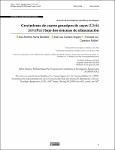Mostrar el registro sencillo del ítem
Crecimiento de cuatro genotipos de cuyes (Cavia porcellus) bajo dos sistemas de alimentación
| dc.contributor.author | Sarria Bardales, José Antonio | |
| dc.contributor.author | Cantaro Segura, Jose Luis | |
| dc.contributor.author | Cayetano Robles, Jovana Luz | |
| dc.date.accessioned | 2021-11-11T16:05:27Z | |
| dc.date.available | 2021-11-11T16:05:27Z | |
| dc.date.issued | 2020 | |
| dc.identifier.citation | Sarria Bardales, J. A., Cantaro Segura, J. L., & Cayetano Robles, J. L. 2020. Crecimiento de cuatro genotipos de cuyes (Cavia porcellus) bajo dos sistemas de alimentación. Cienc. Tecnol. Agropecuaria, 21 (3): e143. https://doi.org/10.21930/rcta.vol21_num3_art:1437 | es_PE |
| dc.identifier.uri | https://hdl.handle.net/20.500.12996/5028 | |
| dc.description | Universidad Nacional Agraria La Molina. Escuela de Posgrado. Maestría en Producción Animal | es_PE |
| dc.description.abstract | Se evaluaron los principales parámetros técnicos de cuatro genotipos de cuyes mejorados disponibles en laactualidad y sometidos a dos sistemas de alimentación (mixto e integral) durante la etapa de crecimiento.Se utilizaron 96 cuyes machos recién destetados (15 ± 3 días) pertenecientes a los genotipos: Cieneguilla-UNALM, Perú-INIA, Cuy G-IVITA/Mantaro/UNMSM e Inkacuy-UCSS. Las dietas peletizadas y elagua fueron ofrecidos ad libitum durante ocho semanas, mientras que el forraje (chala) solo se suministróa los tratamientos mixtos. Se utilizó un diseño completo al azar con arreglo factorial de ocho tratamientosy tres repeticiones de cuatro animales por cada repetición, donde los factores fueron el genotipo, por unaparte, y el sistema de alimentación (mixto e integral), por otra. Los resultados indican que, a nivel degenotipos, Cieneguilla, Cuy G e Inkacuy registraron mejores pesos y ganancias de peso (p < 0,05) que elgenotipo Perú. La conversión alimenticia favoreció (p < 0,05) al tratamiento T2 (Cieneguilla-integral); engeneral, el genotipo Cieneguilla-UNALM tuvo mejor desempeño que los demás, mientras que los sistemascon y sin forraje —con excepción del consumo que fue mayor en el primero (p < 0,05)— tuvieron uncomportamiento similar (p > 0,05). | es_PE |
| dc.description.abstract | The main technical parameters of four improved guinea pig genotypes currently available and subjectedto two feeding systems (mixed and integral) during the growth stage were evaluated. Ninety-six newlyweaned male guinea pigs (15 ± 3 days) belonging to the genotypes: Cieneguilla-UNALM, Peru-INIA,Cuy G-IVITA/Mantaro/UNMSM, and Inkacuy-UCSS were used. Pelletized diets as well as water, wereoffered ad libitum for eight weeks, while forage (maize husks) was only supplied to the mixed treatments.A completely randomized design with a factorial arrangement of eight treatments and three replicates offour animals in each was used. The factors were the genotype on the one hand, and the feeding system(mixed and integral) on the other hand. The results showed that, at the genotype level, Cieneguilla, CuyG and Inkacuy recorded better weights and weight gains (p < 0.05) compared to Perú. Feed conversionfavored (p < 0.05) the T2 treatment (Cieneguilla-integral); in general, the Cieneguilla-UNALM genotypeperformed better than the others; meanwhile, the systems with and without forage, except for intake thatwas higher in the first (p < 0.05), showed a similar behavior (p > 0.05) | en_US |
| dc.format | application/pdf | en_US |
| dc.language.iso | spa | es_PE |
| dc.publisher | AGROSAVIA | es_PE |
| dc.rights | info:eu-repo/semantics/openAccess | en_US |
| dc.source | http://revista.corpoica.org.co/index.php/revista/article/view/1437 | es_PE |
| dc.subject | Cobaya | es_PE |
| dc.subject | Razas (animales) | es_PE |
| dc.subject | Genotipos | es_PE |
| dc.subject | Sistemas de alimentación | es_PE |
| dc.subject | Piensos concentrados | es_PE |
| dc.subject | Forraje verde | es_PE |
| dc.subject | Periodo de crecimiento | es_PE |
| dc.subject | Ganancia de peso | es_PE |
| dc.subject | Consumo de piensos | es_PE |
| dc.subject | Eficiencia de conservación del pienso | es_PE |
| dc.subject | Análisis económico | es_PE |
| dc.subject | Evaluación | es_PE |
| dc.subject | Perú | es_PE |
| dc.subject | Cuyes | es_PE |
| dc.subject | La Molina (dist) | es_PE |
| dc.title | Crecimiento de cuatro genotipos de cuyes (Cavia porcellus) bajo dos sistemas de alimentación | es_PE |
| dc.title.alternative | Growth of four guinea pig (Cavia porcellus) genotypes under twofeeding systems | en_US |
| dc.type | info:eu-repo/semantics/article | en_US |
| dc.identifier.doi | https://doi.org/10.21930/rcta.vol21_num3_art:1437 | es_PE |
| dc.subject.ocde | https://purl.org/pe-repo/ocde/ford#4.02.01 | es_PE |
| dc.publisher.country | CO | es_PE |
| dc.type.version | info:eu-repo/semantics/publishedVersion | en_US |


